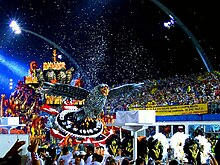Carnival of São Paulo
You can help expand this article with text translated from the corresponding article in Portuguese. (April 2020) Click [show] for important translation instructions.
|

The Carnival of São Paulo (Portuguese: Carnaval de São Paulo) is a major Brazilian Carnival. It features a parade of Samba schools and takes place in the Anhembi Sambadrome of São Paulo on the Friday and Saturday night of the week of Carnival.[1] It is currently considered one of Brazil's biggest and most important popular events.
History[edit]
The origins of Carnival stem from a game from the 15th century in which people would throw water and other liquids at each other.[2] Since then, it has evolved and taken different forms in the various places it has spread to. São Paulo was heavily influenced by the people who migrated from the countryside to the city, as well as by the context of the coffee sector crisis.[3] Therefore, the population of São Paulo was the result of the rural exodus caused by the coffee crisis that triggered the beginning of the São Paulo Carnival.
The Carnival celebrations and the samba itself in São Paulo are slightly different from the Carnival in the city of Rio de Janeiro, though there is a clear difference in the rhythm of the sound - in other words, the speed and tempo of the music. Samba artists from São Paulo were accustomed to difficult lives on the coffee plantations and migrated to the city in search of labour work. The São Paulo author and journalist Plínio Marcos called São Paulo's samba "the samba of work, hardship, drawn to the drumming", which contrasted greatly with the lyricism and cadence of carioca samba from Rio de Janeiro.
References[edit]
- ^ Francisco de Assis Santana Mestrinel (Chico Santana), "O samba e o carnaval paulistano"
